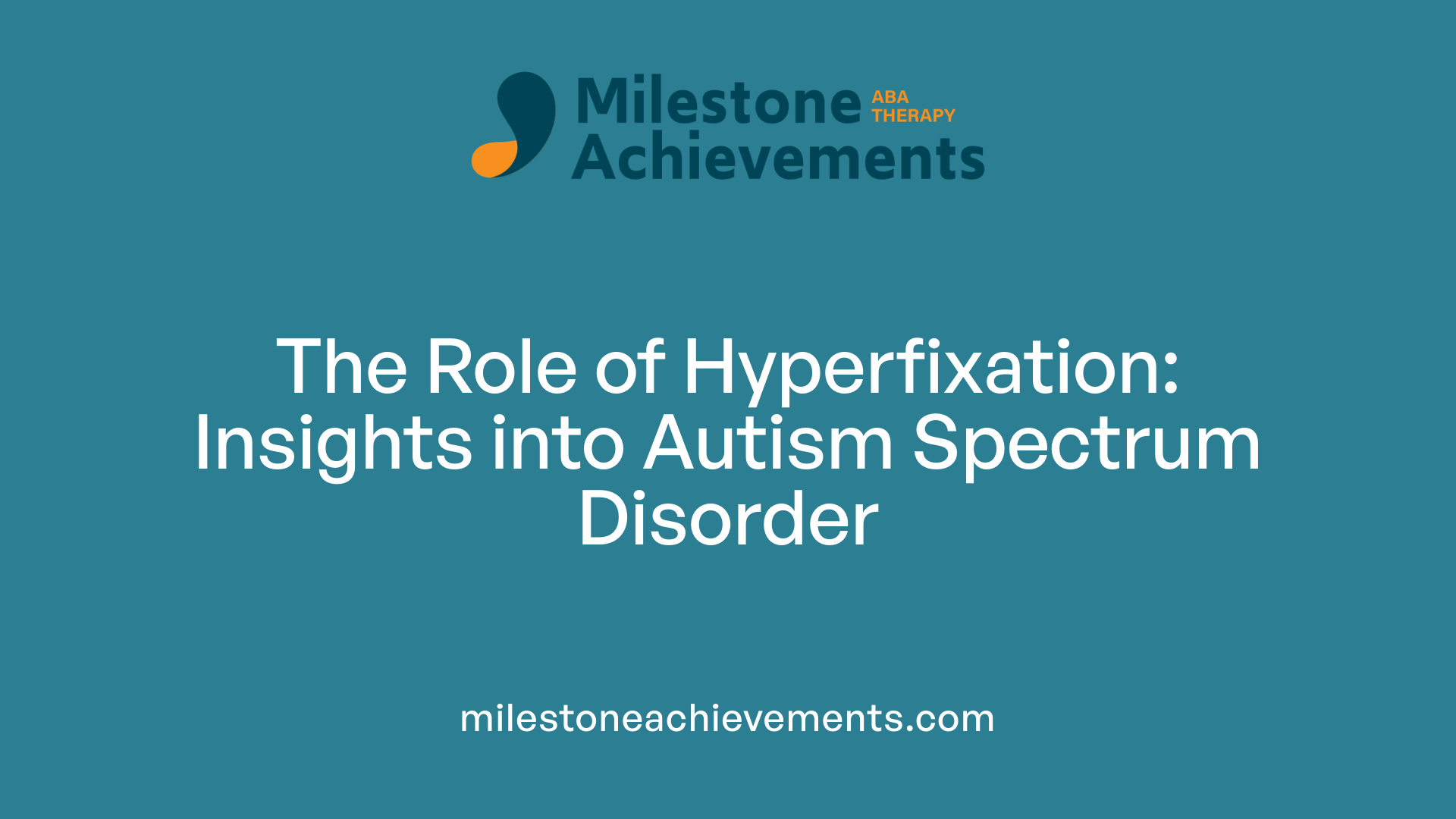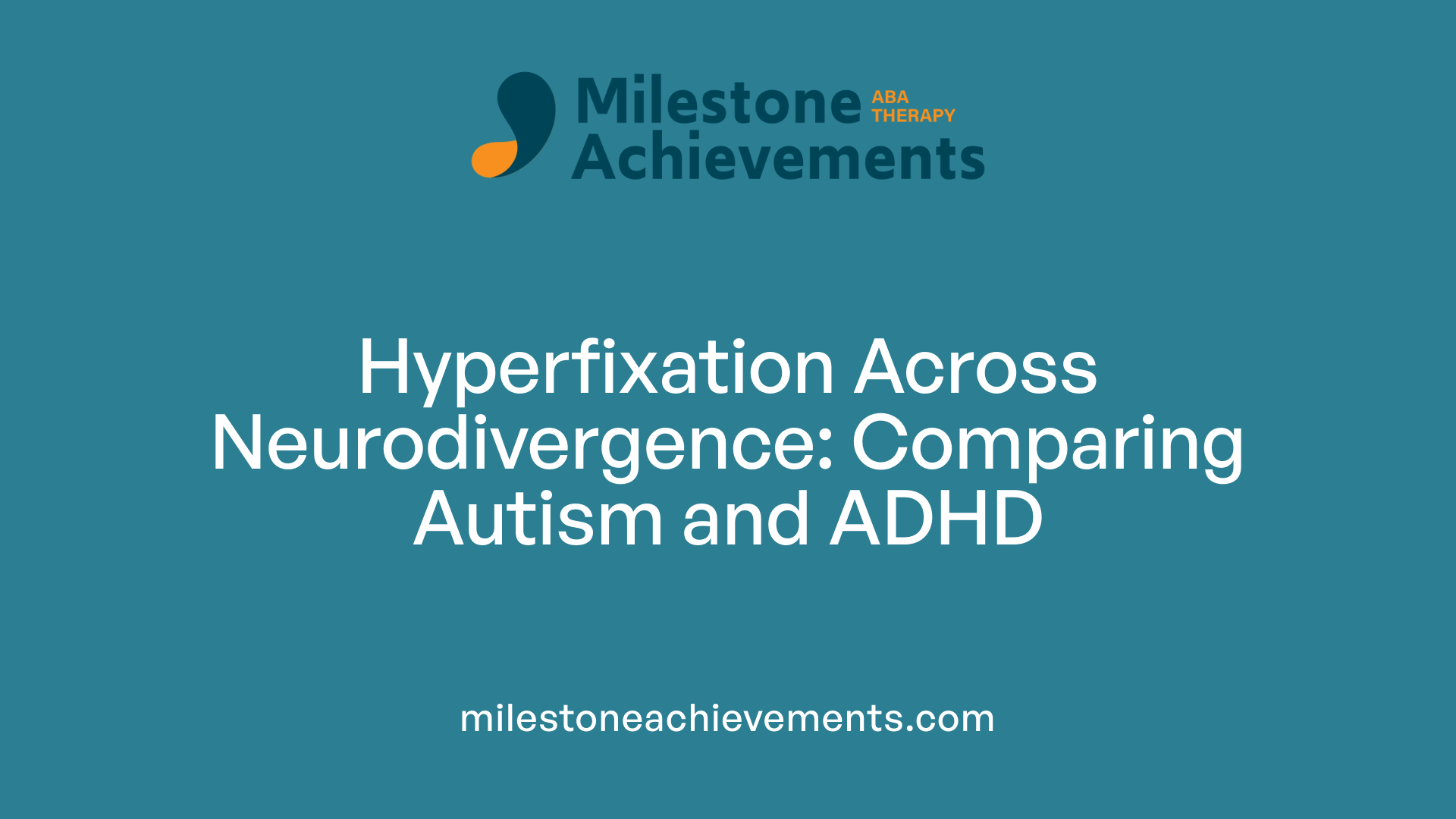
Is Hyperfixation an Autism Symptom?
Understanding Hyperfixation: A Key Feature in Autism Spectrum Disorder
Exploring the Connection Between Hyperfixation and Autism
Hyperfixation is a phenomenon characterized by intense, prolonged focus on specific interests or activities. While it is often associated with neurodivergent conditions such as autism and ADHD, understanding its nuances and implications is essential for recognizing its role in autism spectrum disorder (ASD). This article delves into the signs, causes, manifestations, and distinctions of hyperfixation, highlighting its significance as a characteristic trait within the autism spectrum.
Defining Hyperfixation and Its Core Characteristics

What is hyperfixation?
Hyperfixation refers to an intense and sustained preoccupation with a specific interest, activity, or object. Unlike casual hobbies or interests, hyperfixation involves a level of focus so deep that it can dominate an individual's thoughts and behaviors for long periods, often crossing over days, months, or even years.
Key features of hyperfixation.
This phenomenon is characterized by several distinctive traits:
- Deep absorption in a particular focus, often with a strong emotional component.
- Loss of awareness of time passing or surroundings.
- Persistent desire to learn more or engage repeatedly with the focus.
- Sometimes accompanied by repetitive behaviors or routines centered around the fixation.
How does hyperfixation manifest?
People experiencing hyperfixation often find themselves absorbed in their chosen interest to the extent that they forget about other responsibilities or social engagements. They may dedicate countless hours to their focus, ignore personal needs like eating or sleeping, and struggle to disengage even when they recognize it may be necessary.
Behavioral signs of hyperfixation.
Some common signs include:
- Repetitive thoughts or behaviors related to a specific subject.
- Neglect of work, school, or social commitments.
- Difficulty switching attention away from the fixation.
- Increased knowledge or skills in a particular area.
- Over-involvement in specific routines or activities linked to the fixation.
What are the signs, causes, and implications of hyperfixation?
Hyperfixation manifests as a powerful, prolonged focus on a topic or activity, leading individuals to lose track of time and neglect other aspects of life. Causes can include neurodivergent conditions like ADHD and autism, where differences in dopamine regulation and brain chemistry influence focus and interest levels. Emotional factors such as anxiety or trauma may also play a role.
The implications of hyperfixation are varied. On the positive side, it can lead to developing expertise, fostering creativity, and creating a sense of accomplishment. However, it can also cause challenges—such as social disconnection, neglect of responsibilities, and emotional distress. Managing hyperfixation typically involves setting boundaries, utilizing time management techniques, seeking support from loved ones or professionals, and practicing self-care to maintain a healthy balance.
Characteristics and Manifestations of Hyperfixation

What are the characteristics and manifestations of hyperfixation?
Hyperfixation is marked by an intense and often prolonged attention to a specific activity, object, or interest. Individuals experiencing hyperfixation tend to become completely absorbed, losing track of time and their surroundings. This deep engagement might involve repetitive behaviors such as detailed research, increased emotional investment, or continuous practice.
One prominent sign of hyperfixation is neglect of personal needs or other responsibilities. For instance, someone might spend hours involved in their focus area, ignoring meal times, hygiene, or social obligations. In many cases, hyperfixation can last from several hours to multiple years, especially in neurodivergent populations like those with autism or ADHD.
Common behaviors include obsessive daydreaming, repetitive routines, and a tendency to become experts or highly knowledgeable in their focused area. For example, a person might learn everything about a specific hobby, historical period, or media franchise, sometimes turning their interest into a form of expertise.
This fixation can also manifest through social disconnection, where an individual may prefer engaging with their interest over social interactions. It might lead to difficulty switching away from their focus, causing frustration or distress, particularly when external demands or circumstances interrupt their activity.
While hyperfixation can foster creativity, build skills, and bring joy, it often impacts daily life negatively. It may interfere with responsibilities like work, school, or personal care. Consequently, managing hyperfixation involves establishing boundaries such as time limits, creating physical or environmental cues for switching focus, and seeking support from friends, family, or professionals. Overall, hyperfixation is a complex phenomenon that both enriches and challenges the lives of those who experience it.
Differentiating Hyperfixation from Special Interests
What is the difference between hyperfixation and special interests?
Hyperfixation and special interests both involve a deep focus on certain topics or activities, but they differ significantly in their duration, emotional impact, and role in a person's life.
Hyperfixation is characterized by an intense, often obsessive focus on a specific task or activity, which can last from hours to several months. It is common among individuals with ADHD and autism and may lead to neglect of responsibilities, social interactions, and personal needs. Hyperfixation tends to be more transient, with a tendency to shift from one obsession to another over time. It can cause frustration or distress if it interferes with daily functioning.
In contrast, special interests are long-term, highly focused passions that typically develop gradually during early childhood but can also emerge in adulthood. These interests tend to be more stable and deeply integrated into an individual's sense of identity, especially among autistic people. They often influence career choices, hobbies, and social connections. Special interests can last for years—sometimes contending with decades—and contribute positively to skills development and self-esteem.
Emotional and social implications differ as well. Hyperfixation may lead to feelings of overwhelm or frustration, especially if routines are disrupted. Meanwhile, special interests often foster a sense of purpose, help manage stress, and can facilitate social bonding when shared with others.
How do they overlap and differ?
While both hyperfixation and special interests involve focused attention, their primary distinction lies in their stability and prevalence. Hyperfixation may be more fluid, shifting from one subject to another with a high degree of intensity, often driven by emotional needs or impulses. Conversely, special interests tend to be more enduring, forming a core part of a person's identity.
Summary table:
| Aspect | Hyperfixation | Special Interests |
|---|---|---|
| Duration | Hours to months | Years, sometimes lifelong |
| Emotional intensity | Can cause distress | Usually positive and fulfilling |
| Focus area | Often task-specific or activity-based | Broader interests, often in specific fields |
| Role in life | Momentary obsession | Integral to identity and development |
| Impact | Can interfere with daily life | Usually beneficial, enhancing skills |
Understanding these differences helps in managing and supporting individuals appropriately. Recognizing when hyperfixation becomes disruptive versus when a special interest provides joy or growth can guide effective strategies for well-being.
The Role of Hyperfixation in Autism Spectrum Disorder

How prevalent is hyperfixation among autistic individuals?
Hyperfixation is extremely common in people with autism spectrum disorder (ASD). Studies suggest that between 75% and 95% of autistic individuals develop specific interests or fixations that they spend hours focused on. These interests, often called special interests, usually form between ages 1 and 4 but can develop later in adulthood. On average, autistic individuals maintain about two special interests over long periods, sometimes lasting around 13 years.
How does hyperfixation manifest in autism?
In autism, hyperfixation often presents as intense focus on particular topics like transportation, animals, sports, or pop culture. These interests may involve deep knowledge, extensive collection, or artistic expression. People with autism might hyperfocus on their interests for hours, to the point of ignoring other tasks or social interactions. Hyperfixation can lead to detailed learning, skill-building, and even mastery, with some individuals becoming child prodigies or savants.
What are the benefits and challenges of hyperfixation?
Hyperfixation can create positive outcomes such as increased confidence, specialized skills, and creative achievements. Many autistic adults find comfort and stress relief in their interests, which serve as coping mechanisms.
However, there are challenges too. Excessive focus can cause neglect of daily responsibilities, social interactions, and self-care. It might lead to physical exhaustion or emotional distress if the fixation becomes overwhelming. Managing hyperfixation involves setting boundaries, encouraging balance, and supporting adaptive engagement in interests.
How does hyperfixation relate to other autistic traits?
Hyperfixation reflects core autism features such as cognitive rigidity—a difficulty in shifting attention—and sensory sensitivities, which often drive intense interests. This pattern of focus supports routines and provides a sense of control in unpredictable environments.
Furthermore, hyperfixation overlaps with the concept of special interests, although they are often used interchangeably. Special interests tend to involve a broader, more enduring passion, whereas hyperfixation emphasizes the intense and sometimes obsessional aspect of focus.
Relationship to other traits
| Trait | Description | Link to hyperfixation |
|---|---|---|
| Routine preference | Strong liking for predictable routines | Hyperfixations provide familiar, comforting topics or activities |
| Sensory sensitivities | Heightened response to sensory input | Can intensify interests, e.g., fixation on textures or sounds |
| Cognitive rigidity | Difficulty changing focus or plans | Underpins the perseverance seen in hyperfixations |
| Social challenges | Difficulties with social communication | Hyperfixation on particular interests may limit social interactions but also offer common ground when shared |
Hyperfixation’s role in understanding autism
Recognizing hyperfixation helps provide a nuanced picture of autistic cognition. It showcases how intense interests can be sources of strength and community, as well as challenges when they interfere with daily life. Support strategies include emphasizing the positive potential of these interests while encouraging flexibility and balance.
Hyperfixation’s Connection to Autism Spectrum Disorder

How does hyperfixation relate to autism spectrum disorder?
Hyperfixation is a prominent feature observed in many individuals with autism spectrum disorder (ASD). It involves an intense and sustained focus on specific interests or activities, which can last for months or even years. These focus areas, often called 'special interests,' may include topics like transportation, animals, or popular culture, and individuals may develop extensive knowledge or skills within these realms.
This deep engagement can foster benefits such as increased creativity, expertise, and emotional comfort. For instance, some autistic people turn their interests into professional skills, becoming experts or even prodigies.
However, hyperfixation isn’t always positive. It can lead to neglect of daily responsibilities, reduced social interactions, and difficulties in shifting attention from preferred activities. Despite not being an official diagnostic criterion, hyperfixation is widely recognized as a behavioral marker of ASD, illustrating the deep and focused attention characteristic of autistic individuals.
Role of hyperfixation as a behavioral marker
Hyperfixation serves as a useful sign in understanding autism because it reflects the way autistic minds process attention and interests differently. It demonstrates a preference for deep, concentrated involvement over superficial engagement. Many autistic individuals find comfort and stability in their fixations, which can also help in managing stress and uncertainty.
This strong dedication to certain interests can shape social interactions, as sharing knowledge or passion about a favorite topic often replaces more typical social exchanges. Recognizing hyperfixation as part of ASD helps in fostering understanding, support, and tailored strategies for engagement.
Impact on daily functioning
While hyperfixation can be a source of personal strength, it can also interfere with daily life. People with ASD may spend significant amounts of time immersed in their interests, sometimes to the point of neglecting self-care, work, and social obligations.
Efforts to manage hyperfixation involve setting boundaries, creating routines, and involving support networks. When balanced well, hyperfixation can promote skill development and confidence. But when excessive, it requires mindful management to ensure it does not hinder overall well-being.
| Aspect | Description | Impact |
|---|---|---|
| Duration | Can last from months to years | Deep knowledge or skill, but possible neglect of other areas |
| Focus | Intense, narrow interest | Fosters expertise; may cause rigidity |
| Benefits | Creativity, passion, self-soothing | Enhances self-esteem and emotional regulation |
| Challenges | Neglect of responsibilities, social life | Needs management to prevent negative effects |
| Management strategies | Setting time limits, involving support | Promotes healthy engagement |
Hyperfixation Beyond Autism: Exploring Other Neurodivergent Conditions

How does hyperfixation in autism compare to that in other neurodivergent conditions like ADHD?
Hyperfixation manifests differently across neurodivergent conditions, with notable distinctions between autism and ADHD. In autism, hyperfixation is often characterized by highly restrictive, intense interests that become deeply integrated into the individual’s identity. These interests tend to last for years or even a lifetime, providing a source of comfort, emotional regulation, and social connection. People with autism might spend hours learning about a specific topic, developing profound expertise and often incorporating their special interests into daily activities like play, art, or career.
Conversely, hyperfixation in ADHD is generally more transient and fluctuates over time. It involves intense focus on a particular activity or subject for hours or days but with less permanence or personal identity attached. ADHD hyperfixations are more related to seeking stimulation and dopamine release, often shifting rapidly from one interest to another. Individuals with ADHD might neglect basic needs or responsibilities during such periods but typically do not develop the long-term, deeply ingrained interests seen in autism.
In summary, autistic hyperfixations tend to be persistent, long-lasting, and part of a core identity—helping with emotional stability and social bonding. ADHD hyperfixations are shorter-term, activity-driven, and often linked to seeking novelty and stimulation, with a tendency to shift focus quickly. This difference in duration, significance, and impact is crucial for understanding how hyperfixation varies within neurodivergence.
Management Strategies and Support for Hyperfixation
What strategies can help manage hyperfixation?
Managing hyperfixation effectively involves a combination of practical approaches aimed at maintaining balance in daily life. One common method is to set specific time limits for engaging with a particular interest or activity. This helps prevent hyperfixation from taking over the entire day and allows space for other responsibilities.
Creating physical boundaries, such as designated spaces for certain activities, can also help regulate focus and reduce the risk of over-engagement. Incorporating accountability partners, like friends, family, or support groups, provides external checks and encouragement to maintain moderation.
Developing routines that include a variety of activities ensures that interests are balanced with responsibilities like work, social interactions, and self-care. Using timers, alarms, or reminder apps can serve as cues to switch activities or take breaks.
Mindfulness and self-awareness exercises are valuable tools for recognizing when hyperfixation begins to interfere with well-being. These practices promote reflection on feelings and help in adjusting focus accordingly.
For individuals with autism or ADHD, professional support through behavioral therapies, coaching, or occupational therapy can offer personalized strategies. These experts can help craft plans to manage hyperfixation while fostering skills that support daily functioning.
It is important to be attentive to signs that hyperfixation may cause neglect of responsibilities or emotional distress. If hyperfixation significantly disrupts daily life or leads to stress, seeking help from mental health professionals is recommended.
When to seek professional help
While hyperfixation can have its benefits, persistent or intense fixation that impairs daily activities warrants professional support. Therapists can work with individuals to develop effective coping strategies, improve emotional regulation, and address any underlying issues contributing to hyperfixation status.
Balancing focus and responsibilities
Achieving a healthy balance involves setting boundaries around interests, maintaining communication with loved ones, and integrating variety into daily routines. This approach helps harness the positive aspects of hyperfixation—such as skill development and passion—while minimizing potential downsides like social withdrawal or neglect of important tasks.
Embracing and Managing Hyperfixation in Autism
Hyperfixation is a prominent feature in autism spectrum disorder, serving both as a source of strength and potential challenge. Its deep engagement can foster expertise, creativity, and emotional stability, yet it can also lead to neglect of responsibilities and social life if unmanaged. Recognizing hyperfixation’s role within the broader context of autistic traits helps in developing effective strategies for embracing interests while maintaining balance. With awareness, supportive interventions, and practical management techniques, individuals on the spectrum can harness hyperfixation to enrich their lives, promote self-understanding, and foster personal growth.
References
- Food hyperfixation, ADHD, and autism: Why you eat safe foods - Inflow
- What a Hyperfixation Really Is - Time Magazine
- Special Interest vs. Hyperfixation: Differences and Resources
- 6 Tips to Stop Hyperfixating on a Person - Charlie Health
- Special interest (autism) - Wikipedia
- Autism Hyperfixation: 5 Warning Signs You Need To Know About ...
- ADHD & Hyperfixation: The Phenomenon of Extreme Focus
- What is hyperfixation? Symptoms, causes, and how to manage it


Partner with us on your child's journey
Milestone Achievements offers evidence-based ABA therapy to help children with autism reach their full potential. Together we’ll set meaningful goals and celebrate progress every step of the way.
Start ABA Services Today





